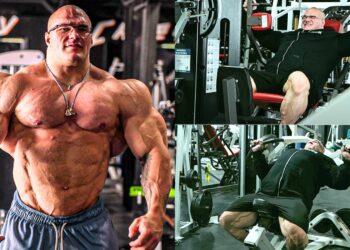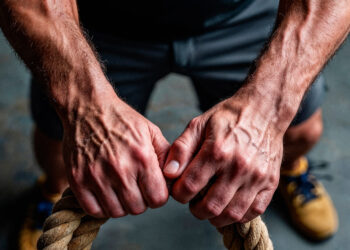The cable wrist curl is an exercise variation used to build the forearm muscles of the lower arm. Typically, a barbell or dumbbell is used for this exercise. However, cables are an excellent tool for training the forearms, and you’ll benefit just as much. Not to mention, there are various ways to utilize cables to achieve this by using different positions and attachments.
Forearms training not only builds muscle; it improves grip strength as well and will make you better and stronger in all of the big (and little) lifts. In this article, we’ve explained how to do this exercise with tips, variations, and there’s some info on how to include it in your training as well.
Here’s a guide to the cable wrist curl…
Muscles Worked
The cable wrist curl is an isolation curl that works the forearm muscles. Here’s a brief description of the anatomy of the forearm muscles.
Forearms
The forearm muscles occupy the space between the wrists and elbow. They are grip muscles that have two components – anterior (flexor) and posterior (extensors) consisting of twenty muscles that contribute to movement of the arms, wrists, and fingers.
A wrist curl will work the forearm flexor muscles on the wrist side of the lower arm.
Level Up Your Fitness: Join our 💪 strong community in Fitness Volt Newsletter. Get daily inspiration, expert-backed workouts, nutrition tips, the latest in strength sports, and the support you need to reach your goals. Subscribe for free!
Related: How To Get Big Forearms
How To Do The Cable Wrist Curl
The cable wrist curl is not a complex movement and it’s one of the easiest variations to do. Here are step-by-step instructions for this exercise.
- Slide the pulley to the bottom of the cable machine and attach a straight or EZ bar.
- Grip the bar with hands about hip-width apart or find a grip that’s most comfortable for you, and stand straight up.
- Curl the bar up toward you and hold for a second, then straighten your wrists and allow the bar to roll down your fingers.
- Curl the bar back up with your fingers and then grip it with your thumbs as it rolls up to complete the curl.
- Repeat for the desired reps.
Here’s a video example…
Cable wrist curl tips
- DO NOT use heavy poundages for this exercise. There’s already enough stress on the wrists and fingertips (if you roll the bar down your fingers). Use no heavier than moderate weights for this exercise.
- You don’t have to roll the bar down into your fingers. This isn’t ideal for everyone and can be dangerous if too much weight is used as explained in the first tip.
- You want to squeeze and hold for at least a second at the top to really engage the forearm muscles.
- Use a grip that works best for you whether it’s narrower or wider. You want to make sure that you’re feeling the muscles contract during the exercise.
4 Variations
While the cable wrist curl is a fantastic forearm exercise, there are plenty of other variations that you can do. Not to mention, not everyone prefers using cables or doing it with their arms positioned in front of their body. So to offer you more options, here are four effective variations of this exercise.
Behind the back cable wrist curl
Cables are undoubtedly the best tool for performing behind the back wrist curls. The reason being is that with cables, your arms can be in any position and it won’t affect the exercise. This isn’t the case with a barbell or dumbbells. For example, when performing the behind the back wrist curl with a barbell and depending on the length of your arms, your butt can get in the way as you curl the weight up and this can interfere with the range of motion. Dumbbells honestly aren’t much better either.
With cables, you can take a step or two forward and your arms can be somewhat extended behind your body and you’ll still be able to do the exercise because of how the machine is designed.
So if you’re going to do this variation, cables are the best tool for the job. But barbell behind the back wrist curls can work too, of course.
It’s also important to note that a lot of people prefer this variation if curling with the hands pronated while standing position. It may allow for a better feeling contraction in the forearms.
Level Up Your Fitness: Join our 💪 strong community in Fitness Volt Newsletter. Get daily inspiration, expert-backed workouts, nutrition tips, the latest in strength sports, and the support you need to reach your goals. Subscribe for free!
Seated cable wrist curl
You can also do this exercise seated and with your forearms resting on your thighs, or with your forearms on the bench between your legs. This variation is different from the basic standing cable wrist curl shown above because you’re using an underhand grip instead of an overhand grip. Also, your forearms are bent ad parallel to the floor so the wrists are placed under a little more stress which means you also shouldn’t do this exercise with heavy weight.
Kneeling cable wrist curl
So for this variation, instead of sitting down on the bench, you’d be kneeling down with your forearms resting on the bench and your wrists hanging off the edge. So you’ll want to place the bench long ways facing the cable pulley and far enough away to keep tension in the cables so the weights don’t touch the rest of the stack as you’re performing the exercise. Again, use a lighter weight with this exercise.
You could also stack something on top of the bench as shown on the below video example…
Barbell/dumbbell wrist curls
Then, of course, you can also use a barbell or dumbbell/s which are probably more commonly used than cables when performing wrist curls. But you have to be a little more strategic when using free weights because you don’t have the luxury of having that constant tension in any position as you do with cables.
For example, with the kneeling wrist curl example above, you’d have to angle your forearms on the bench to keep the tension on the forearms. And we already explained how it’s hard to use free weights for behind the back wrist curls. But in, general, free weights are a great tool for wrists curls especially when you don’t have access to cables. However, are also arguably better for developing grip strength because you can do a lot more functional exercises (e.g., farmers walk) with them, whereas you can’t with cables.
How To Incorporate The Cable Wrist Into Your Training Routine
The best way to incorporate the cable wrist curl is at the end of an upper-body workout or as part of a forearm workout. You don’t want to do this exercise before your main upper body sessions because you’ll exhaust your forearms and your grip won’t be as strong when you need to lift the most amount of weight.
It’s not good when your grip gives out before the muscles that you are training. Therefore, save them for last, and after your main workouts that consist of rows, pull-ups, curls, etc. And the same applies even if you’re not focusing on the upper body but still need a strong grip to be able to perform the exercises.
For example, a lot of exercisers utilize the deadlift as a lower-body training exercise and you must be able to hold onto the bar, otherwise, your performance will suffer big time.
Wrist curls can also be used as a pre-exhaust method before you do biceps curls. By doing a few sets of wrist curls before biceps curls, you may be able to better isolate the biceps because the forearms are too fatigued to contribute as much as they normally would.
Sets/reps
2-3 sets of 8-25 reps is plenty for the cable wrist curl especially if you’re doing other forearms exercises, or if you’ve already done heavy pulls in your workout. The forearms are a small muscle and you don’t need to do as much as you would larger muscle groups.
Also, training your forearms once and twice per week is sufficient if you’re doing lots of pulls and curls.
Wrapping Up
The cable wrist curl is an awesome exercise for pumping up the forearm muscles. It’s also good for improving grip strength and as you learned from this guide, offers advantages over free weight variations. Therefore, we highly recommend that you incorporate some cable forearms training into your workout regime to maximize your development.
Interested in measuring your progress? Check out our strength standards for Wrist Curl, Pull Ups, Deadlift, and more.








